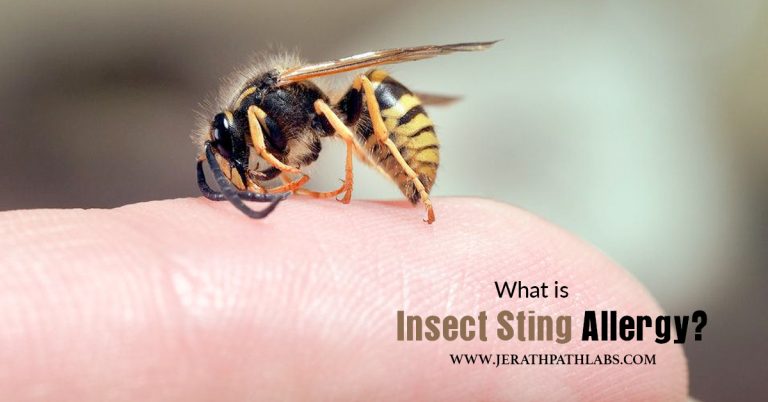If you get stung by a honey bee, wasp or any other insect, would you know whether you had an unfavourably susceptible reaction? Insect bite hypersensitivity is generally given to the human hypersensitivity reaction to a bug sting. We all get stung or nibbled by bugs occasionally, and the vast majority wind up with a little red, itchy knock. Individuals hypersensitive to insect stings or chomps may respond strongly, and the response may even be dangerous in uncommon instances. Typically, bugs that produce unfavourably susceptible reactions are wasps, honey bees, hornets and, ants, and mosquitoes. Whether these insects infuse venom into their victims or typically introduce anti-coagulants into their unfortunate casualties.
It is exceptionally ordinary to have torment, local redness and swelling at the site of the sting. A few people have significant local responses. When a creepy crawly sting causes a generalized response (one influencing the entire body), this is hypersensitivity. In anaphylactic patients, the reaction is progressively aggressive, prompting a fundamental response where the reaction advances from the sting site around the entire body.
In insect venom hypersensitivities, the body’s immune framework assaults certain parts of proteins that enter the body when the bug chomps or stings. Hypersensitive manifestations happen when the venom from the sting triggers the release of histamine, not only at the sting site but more generally. This is something severe and can prompt anaphylaxis, which is conceivably perilous. The risk of unfavourably susceptible responses is highest if a second sting happens 2-8 weeks later.
The Severity of Insect Sting Reactions
The severity of an insect sting reaction differs from individual to individual. But generally, a typical response sets off agony, swelling, and redness around the sting site. A substantial local reaction causes swelling that stretches beyond the sting site. For instance, stinging on the lower leg may cause swelling of the whole leg. Extensive local responses stay for around 48 hours and, after that, gradually show signs of improvement. The most severe response is an unfavourably susceptible. Manifestations include:
- Trouble relaxing
- Hives that show up as a red, itchy rash and spread to regions beyond the sting
- Swelling of the face, throat, or any other part of the mouth or tongue
- Wheezing or trouble gulping
- Restlessness and tension
- Rapid Pulse
- Dizziness
Measures that should be followed to avoid insect sting bites
- Avoid wearing sandals or strolling shoeless in the grass.
- Never swat at a flying bug. If required, tenderly brush it aside or persistently wait for it to leave.
- Do not drink from open beverage jars. Stinging bugs will creep inside and can attracted by the sweet drink.
- When eating outside, attempt to keep food covered consistently.
- Garbage jars stored outside ought to be secured with tight-fitting tops.
- Avoid sweet-smelling fragrances, hair showers and antiperspirants.
- Avoid wearing bright-coloured apparel.
- Yard work and cultivating ought to be done with caution.
- Avoid or expel bug-attracting plants and vines growing in and around the home.
- Spray garbage jars consistently with bug spray, and keep the jars secured.
Risk factors for hypersensitive severe responses to insect venom
- Increasing age (more than 40 years old)
- Cardiovascular illness
- Allergic asthma
- Mastocytosis (an illness in which the body delivers an excessive number of mast cells)
- An extremely hypersensitive response to a bug sting previously.
Test Required For The Diagnosis of Insect Sting Allergy
Diagnosis starts with a discussion during which the specialist asks the patient a detailed therapeutic history, including inquiries concerning previous stings, your response to those stings (what you encountered, to what extent the response endured and what you did to get alleviation) and any extra indications.
Your allergist may perform some tests to analyze sensitivity to insect venom, for example, a skin-prick test, an intradermal skin test or a blood test. In the skin-prick test, a little measure of a fluid containing insect venom is put on the back or lower arm, then pricked with a little sterile probe to enable the fluid to saturate the skin. If reddish and raised, knock develops within 15 to 20 minutes, which shows sensitivity. In the blood test, a blood test is sent to a lab to test for the nearness of immunoglobulin E (IgE) antibodies to bug venom.
Insect sting sensitivity is treated in a two-step methodology:
- The initial step is the emergency treatment of the manifestations of severe reactions when they develop.
- The second step is preventive treatment of the primary hypersensitivity with venom immunotherapy.
Comprehensive Treatment for Insect Stings and Allergic Reactions
Firstly, if you’re stung on the hand, promptly expel any rings from your fingers. Wash the stung area with cleanser and water and apply an antiseptic. Apply a mitigating balm, similar to a hydrocortisone cream or calamine moisturizer, and cover the region with a dry, sterile bandage. If swelling is an issue, apply an ice pack to that area. Emergency treatment incorporates administration of specific medications, for example, epinephrine, antihistamines, and sometimes corticosteroids, intravenous liquids, oxygen and other treatments. Once stabilized, these patients sometimes require close perception in the hospital overnight.
Injectable self-administered epinephrine is often endorsed as an emergency rescue medicine for treating an unfavourably susceptible response. Individuals with previous unfavourably susceptible responses and depend on epinephrine must remember to carry it consistently.
Venom Immunotherapy: With venom immunotherapy, the immune reaction gets weaker and weaker as the body gets accustomed to the presence of an allergen. It can be given as shots placed under the tongue.
To discover peace of mind, contact Jerath Path Labs for precise testing of insect sting allergies.

